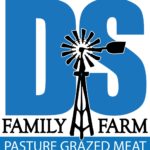Worried about what you are "really" eating? Have peace of mind with pasture grazed meats.
Invisible Microbiome
Should we be at war with invisible microbes OR should we be living in sync with these little critters?
Do you choose to be pro-biotic or anti-biotic?
Since WE are a biotic organism, I most certainly hope you answered that last question with a resounding “I am PRO-biotic“. Then why do we as a culture dump tons of anti-biotics (posions/toxins/pesticides) into our ecosystem every year? Yes, I get it…the fear of a few bad bugs often overcomes common sense to balance risk and to rejoice in the multitude of good bugs that make us who we are.

According to Dr. Zach Bush, almost half of the information (micro-rna/dna/genes/code) that makes me Doug Garrison, comes from microbes living around, on and in me… (that goes for you also). The rest of the information comes from my past living environment and the genes inherited from our parents (who were also greatly influenced by their environment and the information from the environment of their parents, etc.). We are constantly influenced by the world around us.
Probably best that you hear directly from Dr. Bush. The video link below starts 38 minutes in to his presentation and the key point is covered in 6 minutes (38:00 – 44:00). SPOILER ALERT: Listening to this may make you rethink eating grocery store chicken. How microbes and the food we eat influence us (with an interesting take on viruses), Dr. Zach Bush:
“Pest-centric Society”
Let’s look at an agriculture example of pro-biotic versus anti-biotic. Current thinking is that for every “bad” insect that affects agriculture production there are 3,500 “beneficial” insects. When we apply a pesticide to “take out” a bad bug we end up taking out a large number of the good bugs. Overall result is simplification of the ecosystem. When diversity is lost, the bad bugs do not have the natural check from the beneficial bugs and the problem can become worse.
I am not saying that anti-biotics (pesticides) never should be used, but one should consider the long term or unintended consequences when using these tools. Obviously we should consider alternatives to pesticides as described by the folks at Blue Dasher Farm in South Dakota. In some cases, using the anti-biotic ends up causing more harm.
I understand that considering the long-term in a decision made today is not intuitive in our culture and I struggle with it myself. We can learn and reflect on the 7th Generation principle from our Native American friends.
Coronavirus and the herd microbiome
Yes our cattle herd microbiome includes strains of the Coronavirus. Bovine coronavirus is associated with calf diarrhea, winter dysentery and respiratory infections such as shipping fever. Once and a while we will have a “weasing” individual in the herd (cows get colds just like us).

At some point the herd microbiome will probably include the COVID-19 virus. Most likely the herd already has a strain of coronavirus that is unknown to us, maybe Bovine COVID-20A, B or C? As Dr. Bush notes in the video link above, we think there are 100,000,000,000,000,000,000,000,000,000,000 (10 to the 31st power) virus strains in the world… and new ones are mutating all the time. Now that is diversity!
Our personal microbiome
We have a couple past blog posts you may like to review as you ponder your microbiome:
Dr. Bush encourages us to get out into “wild areas” (swamps, forests, range) and breathe in deeply to enhance our microbiome. We invite you out to visit the pasture and the herd. There truly is a microbiome bubble around each of us and especially a herd of cattle. When you walk into our herd’s “bubble”, the feel and smell is immediately recognizable by an earthiness. Trust us, a pasture grazed herd smells somewhat pleasant and will be sure to ignite your inner microbiome.
For further information on Dr. Zach Bush:
October 2020 Update – The Virome is separate from Microbiome:
A virus is not part of the microbiome. “They are not alive, just genomic information wrapped up in a protein.” Learn more about microbes, virus and exoxomes on Dr. Bush’s “Knowledge VIROME” webpage (video). Listen to the 30 minute video for his take on Corona virus. Dr. Bush postulates the extra Carbon particles in our air at the end of the growing season and beginning of the non-growing season (bottom of the brown arrow) is why the flu virus shows up when it does each year (see image below taken from our previous blog post Soil Carbon – CO2). We appreciate his insights and his championing of regenerative agriculture.





